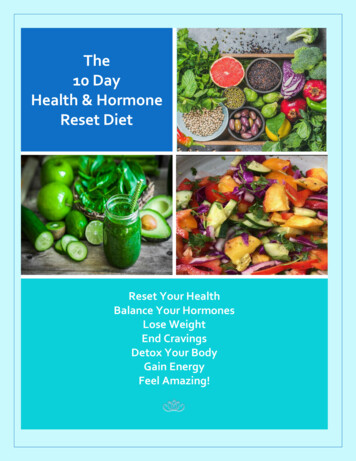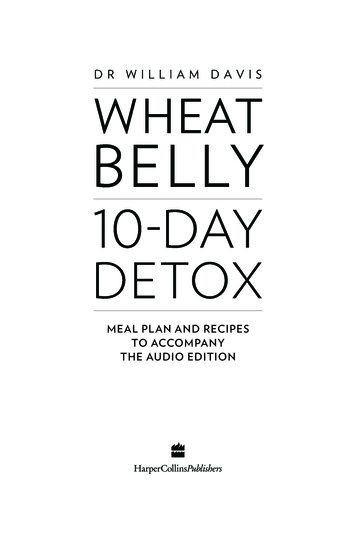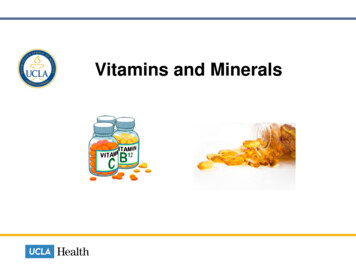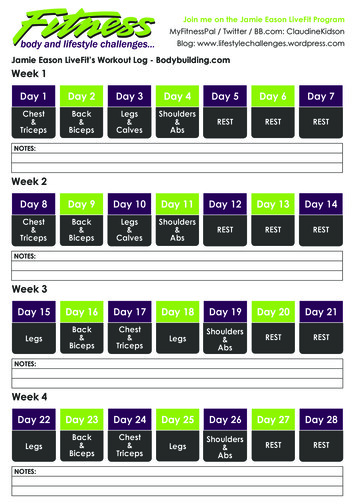
Transcription
The10 DayHealth & HormoneReset DietReset Your HealthBalance Your HormonesLose WeightEnd CravingsDetox Your BodyGain EnergyFeel Amazing!
IntroductionA health reset is sometimes necessary to getyou back on the path to better sleep, moreenergy, better moods, weight loss and goodhealth.A detox diet like this 10 day program helps to ridyour body of toxic chemicals, digestive ‘sludge’,and inflammation. All of these things may beaffecting your hormones in a negative way,causing worsening symptoms, weight gain, fluidretention, sleep problems, a slow thyroid,weight gain, hot flashes, mood swings, oranxiety and depression. The good news is: Youcan actually bring balance back to yourhormones and your health with a detox diet likethis!Detoxing will also activate your healthy gutbacteria and help you feel happier, lighter and healthier! Healthy gut bacteria contribute 90% of our brain’sfeel good chemicals, so cleaning house—so to speak—will help you feel happier and clear out anxiety,depression, or irritability. You may be surprised at how much diet and lifestyle can cause or eliminate anxietyand depression!How does this diet help me with hormone issues? Even for women of child-bearing age, peri-menopause,menopause, and even post-menopause, there can be a wide range of symptoms related to hormones andthose symptoms affect every woman differently. Some of the symptoms—PMS, hot flashes, insomnia, brainfog and mood changes can be severe enough to make it difficult to get on with normal day to day living. Notto mention other health issues such as weight gain, bloating, moodiness, lack of energy and more.
Diet, Inflammation and HormonesInflammation can most definitely exacerbatehormonal symptoms whether male or female—and diet and lifestyle practices can play a hugerole in this.Our Standard American Diet is highlyinflammatory. We eat large quantities of meatraised on inflammatory grains, full of pesticides,antibiotics and hormones. Conventionallyraised, grain-fed meat is also full ofinflammatory omega 6 fats, instead of the anti-inflammatory omega 3 fats in wild caught fish, pasture-raisedchickens and grass fed meats. Women on the western side of the globe tend to consume more than twice asmuch red meat, and four times as much fat (usually in the form of inflammatory omega 6 fats), as women ona traditional Asian vegetable, fish and rice based diets. Women who consume larger quantities of processedvegetable oils, dairy products, and high sugar, high starch diets have the highest levels of inflammatorybiomarkers, body weight (BMI), PMS, and menopausal symptoms such as hot flashes, night sweats, muscleand joint issues and bladder problems. Women on this type of diet also report far more negative symptoms inthe perimenopausal period as well. All of this not only creates higher levels of inflammation in our bodies, butthe growth hormone and antibiotics in conventional meat and dairy also makes our own hormones gohaywire—and that can create problems with estrogen dominance causing a wide variety of negative healthsymptoms.Fiber and Its Role with Hormones and EstrogenResearch shows that women who eat a high-fat/ low-fiber diet experience higher estrogen levels at allpoints in their lives. This throws our other hormones out of balance, including the delicate balance betweenestrogen and progesterone. This creates a condition called, “Estrogen Dominance”. Estrogen dominancecontributes to problems like heavy periods, weight gain, bloating, breast tenderness, fibroids, endometriosis,lack of interest in sex, moodiness, PMS and more. As ovaries slow their production of estrogen during premenopause, peri-menopause and menopause, the women on the unhealthy low fiber diets have the mostdramatic drop in estrogen which can cause the worst hormonal and menopause symptoms. And to make
matters worse, progesterone levels plummet during this time, but estrogen levels can still be too high inrelation to progesterone.Why Does Fiber Help? Fiber helps regulate and balance estrogen. In one study, researchers found that among250 women ages 18 to 44, those who reported eating the most fiber had the lowest blood levels of estrogenand other reproductive hormones. Why is this good?High-fiber diets, they explain, help to sweep out excess estrogen, leading to less estrogen reabsorption in thecolon. Fiber actually causes more estrogen to be excreted from the body in feces. This is a good thing, healthwise. It helps prevent the problems of estrogen dominance which can be detrimental to health, contribute toweight gain, and increase the risk of cancer. And yes, even men can become estrogen dominant leading to ahost of other health problems, including loss of sex drive, man boobs, weight gain and mood changes.In addition, artificial estrogens in our environment—in our personalcare products, in food containers, plastics, cleaning solutions, watersupply, and pesticides are all absorbed into our bodies.These artificial estrogens, or xenoestrogens, are very harmful to ournatural hormone function, significantly increasing the risk of cancer,and even further exacerbating perimenopausal and menopausalhormone symptoms. Xenoestrogens contribute to the estrogendominance problem, so it’s important get these foreign estrogens outof our bodies as quickly as possible. In men, xenoestrogens are especially harmful, decreasing testosteroneand fertility, contributing to depression, and causing female-related physical traits, like excess fat in the chestand breast area—‘manboobs’. Xenoestrogens also raise the risk of cancers for men as well.
Why Veggies are So ImportantVegetables are very important in balancing all hormonesand your health in general. They also increase antioxidantlevels which in turn lowers negative hormone symptoms –including menopausal symptoms, helping you lose weightand protecting your body from a wide variety of diseases.This study from Tehran University of Medical Sciences onwomen, menopause and diet showed that the women whoconsumed more vegetables had the lowest reportedmenopause symptoms and also lower BMI.In one of the biggest studies on diet and hormones, thisone-year intervention study of over 17,000 menopausalwomen, showed that the women who consumed the mostvegetables, fruit, fiber and soy experienced an average of 20% reduction in hot flashes compared to thecontrol group. This reduction in hot flashes was attributed to the healthier diet, high levels of antioxidants,plentiful fiber, and weight loss. While this study was aimed primarily at menopausal women, this type of dietapplies to men and women at any age—higher antioxidants help to create more balanced hormone levels.In addition to eating more vegetables and (small amounts of) fruit, it is important to include plenty ofcruciferous vegetables. Cruciferous vegetables include broccoli, cauliflower, kale, brussels sprouts, arugula,kohlrabi and cabbage.One study on cruciferous vegetables showed that increased intake was linked to lower levels of estrone (atype of estrogen in the body) And this study, it was showed that an increased consumption in the brassicatype of vegetables (cruciferous) transformed estrogen hormone metabolites to significantly lower the risk ofbreast cancer in women and other cancers in men and women.
A Few Words about Grains, Inflammation, Hormones and Weight GainGrains of all kinds—whether ‘whole-grain’ orground into a processed flour and made intobreads, pastas, crackers, pizza crust, etc. arehighly inflammatory and high-glycemic aswell, meaning they raise blood sugar.In other words, any type of grain will raiseblood sugar, and results in bloating, weightgain, inflammation and hormonefluctuations.Foods that spike blood sugar are not only physically addictive, but they increase inflammation in the body.Grains also do more than raise blood sugar; they also raise insulin levels, cause problems with thyroid function(which can lead to depression, weight gain and fatigue) and interfere with optimal levels of leptin (ahunger/satiety hormone), causing people to overeat.In addition, hormone changes are also inflammatory, and can elevate levels of CRP, a primary inflammatorymarker that is connected to heart disease and other chronic health issues. An inflammatory diet that includesgrain can make this risk even worse. A high-glycemic diet is also associated with oxidative stress in pre-andpost-menopausal women. This study of over 117,000 men and women aged forty to seventy found thathigher carbohydrate intake was associated with an increased risk of heart disease in both women andmen.Grains also contain anti-nutrients, along with gluten, a protein in wheat that causes inflammation andautoimmune reactions. These proteins in grains are associated with leaky gut, inflammation and overgrowthof bad gut bacteria. Grains also contain phytates which also cause leaky gut, and block absorption of calcium,iron, magnesium, potassium and zinc. Grains contain digestive enzyme inhibitors which can cause undigestedproteins to leak into the bloodstream creating inflammation, overstimulation of the immune system and foodallergies/sensitivities.And—there’s the gluten issue. Gluten is just one of the proteins in wheat that can cause a variety ofsymptoms including bloating, nausea, diarrhea, and gut inflammation. Even if you are not having a strong
reaction to gluten, it can still be triggering reactions and inflammation. Gluten’s ability to createinflammation, weight gain, digestive issues, and mess with hormone levels should not be overlooked.While many doctors can test for gluten sensitivity, it may not always show up—depending on the test.Standard blood tests for gluten sensitivity only pick up about 15-20% of reactions. Current tests onlyscreen for one component of wheat, alpha gliadin. Yet people can react to at least 12 different portionsof the wheat protein.What does this have to do with hormones? As we age and our hormone levels begin to fluctuate,inflammation and long-term sensitivity to certain proteins such as gluten, can suddenly appear, so digestiveissues, inflammation, bloating, weight gain, and diarrhea can develop—at most any age.Inflammation can cause hormone symptoms to drastically intensify, in addition to being linked to anincreased risk of osteoporosis, thyroid disease, anemia, and even diabetes. And it’s not just the gluten inwheat that can be a problem, rye, barley and sometimes oats can cause similar reactions. Corn, and even ricecan also have a cross-reactivity reaction as well, so truthfully, you are better off avoiding all grains—even thewhole grain ones or gluten free substitutes!It’s a fact that women with undiagnosed celiac disease or those who are diagnosed celiac or gluten sensitiveand don’t follow a strict gluten free diet, will have a much harder time with PMS, peri-menopause andmenopause. Women who have gluten sensitivity or celiac disease can also enter menopause earlier, havehigher than normal occurrence of osteoporosis, a higher than normal risk for lymphoma, and other serioushealth issues .Giving up your bread, pasta, pizzas, crackers, andother baked goods may seem like a huge sacrifice,but the rewards of your health, wellbeing, hormonebalance and even weight loss should make it allworthwhile. Fortunately, there are some great grainsubstitutes available, like tortillas made with coconut,cassava or almond flour; noodles and pasta madefrom black beans, bread made with almond flour andeven pizza crust made from cauliflower.
The Truth About DairyAccording to Walter Willet, M.D., Phd -- the second-most-cited scientist in all of clinical medicine and the headof nutrition at Harvard's School of Public Health, who has done many studies and reviewed the research onthis topic, there are many reasons to pass up milk, including:1. Milk doesn't reduce bone fractures--Contrary to popular belief, eating dairy products has never beenshown to reduce fracture risk. In fact, according to the Nurses' Health Study dairy may increase risk offractures by 50 percent!2. Less dairy, better bones--Countries with lowest rates of dairy and calcium consumption (like those in Africaand Asia) have the lowest rates of osteoporosis.3. Calcium isn't as bone-protective as we thought-- Studies of calcium supplementation have shown nobenefit in reducing fracture risk. Vitamin D, vitamin K2, and magnesium appear to be much more importantthan calcium in preventing fractures.4. Dairy products may raise cancer risk--Research shows that higher intakes of both calcium and dairyproducts may increase men and women’s risk of certain cancers by 30 to 50 percent. Plus, dairy consumptionincreases the body's level of insulin-like growth factor, (IGF-1) -- a known cancer promoter.5. Calcium has benefits that dairy doesn't--Calcium supplements, but not dairy products, may reduce the riskof colon cancer.6. Not everyone can stomach dairy--About 75 percent of the world's population is genetically unable toproperly digest milk and other dairy products -- a problem called lactose intolerance.Based on such findings, Dr. Willet has come to some important conclusions Everybody needs calcium -- but probably not as much as our government's recommended daily allowance(RDA) and calcium from diet, including greens and beans is better utilized by the body with less risk thancalcium supplements. We need magnesium, potassium, vitamin K2 and vitamin D for strong bones. Calcium probably doesn't prevent broken bones. Few people in this country are likely to reduce theirfracture risk by getting more calcium. Conventional dairy is unhealthy. Dairy consumption has negative effects on health.If all that isn't enough to swear you off milk, there are a few other scientific findings worth noting. The FederalTrade Commission (FTC) recently asked the UDSA to look into the scientific basis of the claims made in the"milk mustache" ads. Their panel of scientists stated the truth clearly: Milk doesn't benefit sports performance. There's no evidence that dairy is good for your bones or prevents osteoporosis -- in fact, it may cause boneloss!
Dairy is linked to several different types of cancers in men and women. Dairy causes digestive problems for the 75 percent of people with lactose intolerance.Plus, dairy contributes to other health problems, including: Allergies and Sinus problems Ear infections Type 1 and type 2 diabetes Chronic constipation AnemiaDue to these concerns, many have begun to consider raw milk an alternative. But that isn't really a healthyform of dairy either .From an evolutionary point of view, milk is a strange food for humans. Until 10,000years ago we didn't domesticate animals and weren't able to drink milk (unless some brave hunter-gathermilked a wild tiger or buffalo!).Our bodies just weren't made to digest milk on a regular basis. Instead, most scientists agree that it's betterfor us to get calcium, potassium, protein, and fats from other food sources, like whole plant foods -vegetables, fruits, beans, whole grains, nuts, seeds, and seaweed.Try this: Avoid all dairy. That means eliminate milk, cheese, yogurt, and ice cream for two weeks and see if you feelbetter. You should notice improvements with your sinuses, post-nasal drip, headaches, IBS, energy, andweight. Then start eating dairy again and see how you feel—dairy often affects moods as well. If you feelworse, you should try to give it up for good. If you can tolerate dairy, use only raw, organic dairy products. I suggest focusing on fermented products likeunsweetened yogurt and kefir, occasionally. I like occasionally having some sheep’s milk Unpasteurizedcheese.Milk also contains opiate like substances, so when you get ready to quit, realize that you may actually havewithdrawals for a day or two, but this is normal. Your body is much better off without dairy!
Dietary Guidelines1. Keep the fiber highEat plenty of organic vegetables and a little fruit. Try to get in a pound of veggies a day, which isn’t toohard if you throw some greens in with your eggs or smoothie in the morning, eat a big salad for lunchand have a dinner with healthy proteins and a big serving of veggies. This will help fill you up withantioxidants, vitamins, minerals and other phytochemicals—all of which help ease menopause, lowerinflammation and help you feel full. Fiber helps to gently lower estrogen levels in the body and easesthe symptoms. This helps with weight loss too! Be sure to include plenty of cruciferous vegetables likecauliflower, cabbage, brussels sprouts, broccoli, arugula, etc. And add in some non-GMO, fermentedsoy such as tempeh or miso to help further balance hormone levels.2. Avoid sugars and grains completely—especially from processed foodsSugar is the number 1 promoter of chronic disease and weight gain—and it lowers immune functiondrastically. Even cancer cells LOVE glucose and feed off of it! Sugar in all forms promotes cancer,diabetes, heart disease, autoimmune disease, inflammation, gut dysbiosis, and obesity. In addition,
sugar most definitely weakens the body’s immune defenses and makes it more likely for you to getsick. Removing all sugar and refined carbs will help to reset the body’s fat burning ability, and lowerblood sugar. Cut out ALL foods that contain sugar, refined carbohydrates, grains, and even fruit—fornow. Especially be sure to remove any fructose or high fructose corn syrup—this is like ‘jet fuel’ for fatstoring and disease.Avoid these types of sugar: fructose (natural sugar from fruits)lactose (natural sugar from milk)sucrose (made from fructose and glucose)maltose (sugar made from grain)glucose (simple sugar, product of photosynthesis)dextrose (form of glucose)Remove all processed carbohydrates such as breads, pastas, muffins, cookies, crackers, chips, cereals,etc. Avoid even foods made from “whole grains”. While these foods are often considered ‘healthy’,they are not. They are full of added sugars, highly refined grains (which turn into sugar in our bodies),additives and pesticide residues including glyphosate, a known gut-destroyer, and a proven carcinogen.Avoid convenience meals, frozen dinners, and fast foods—these are processed foods to avoid! Bakedor fried carbohydrates are also full of advanced glycated end products, or AGE’s as well. AGE’saccelerate aging and chronic disease, including cancers.Keeping your blood sugar stable helps to balance hormones, calm your nerves, give you more energy,and stop the blood sugar ups and downs which sap your energy. Lower glycemic foods and lowerblood sugar levels help you continue to burn fat for energy, keep insulin levels lower which helps fightcancer, helps you lose weight and helps to lower levels of unhealthy estrogens.Lower blood sugar also goes a long ways toward lowering inflammation levels which in turn drasticallyreduce heart attack, diabetes and cancer risks. Avoiding grains also help your body to better absorbnutrients from foods. You will get all the fiber you need from vegetables. Many studies find that theglycemic load of a postmenopausal woman’s diet is a strong predictor of her fat mass. Keep in mindthat lowering your glycemic load basically means avoiding all grains and sugars.
3. Keep it Low CarbOn a detox, you want to not only help your body remove toxic sludge, but you also want to reset yourblood sugar levels and your body’s primary energy source. Excessive carbohydrates and sugars in thediet will cause your body store fat and NOT burn fat for energy.While the body can easily burn through sugar and carbohydrates for energy, it is meant purely to be anemergency fuel for the ‘fight or flight’ response. Keeping your blood sugar low allows your body to turnon its ‘fat burning’ switch.A low carb detox diet consisting of vegetables with organic, naturally-raised meats/poultry/fish andhealthy fats will turn your body back into a fat burning machine, drastically lower inflammation,balance out hormones, and boost immune function. Burning your own body fat for fuel will help youthink more clearly, reduce hunger, eliminate excess fluids, lower blood pressure, boost fat loss, andimprove cholesterol ratios.Studies now show that a low carb diet can help lower risk factors for heart disease, Alzheimer’s, anddiabetes. In addition, a low carb or even ketogenic diet starves cancer cells, reduces seizures inepileptics, helps the brain recover from brain injuries better, and improve symptoms of Parkinson’sand multiple sclerosis.4. Go Easy on the Dairy ProductsDairy is one of the most inflammatory food groups—especially if it’s conventionally raised dairy, whichis full of growth hormones and lactation hormones. Inflammation is of course, one of the things thatcauses the body’s hormones to go awry. When you eliminate dairy products, including cheese, cream,milk, yogurt, etc., you may see symptoms like anxiety, depression, fatigue, sinus problems anddigestive issues just fade away.Dairy, along with gluten, is one of the most common hidden food sensitivities. And you will most likelybe able to fit into your ‘skinny’ jeans again, as the inflammation subsides, and your hormones begin tobe back in balance again.
5. Eat healthy proteins, naturally raisedBe sure to get in 50-100 grams of protein per day from natural sources. Natural sources include grassfed meats which are high in omega 3 fats, lower in omega 6 fats and high in conjugated linoleic acid(CLA) which fights cancer, protects the heart and burns fat better.Other natural proteins are pasture raised eggs, also high in omega 3 fatty acids and other valuablenutrients, pastured chicken, and wild caught fish. Avoid as much as possible any animal products fromconventionally raised animals, including dairy, as these foods all contain harmful disruptinghormones, antibiotics, pesticides and unhealthy fats.What really does seem to work best for overall health and hormonal is a primal/paleo-style diet:naturally raised meats and protein, small amounts of fruit, healthy fats, nuts, vegetables, eggs,berries, and fish. Avoid grains, most legumes, sugars, dairy, potatoes, and added salt.6. Move moreStart pumping the oxygen naturally by getting in some light to moderate exercise each day for 45minutes. When you exercise, you get your heart pumping harder, which increases your circulation andcirculating oxygen.Exercise also helps to stimulate your immune system and get your lymph system in gear removingtoxins and clearing out dead cells. Exercise and oxygen actually help to starve cancer cells as well. And,exercise helps improve your mood by increasing your endorphins—your ‘feel good’ chemicals. Apositive mood actually helps the body heal better and faster.However, keep in mind your body is working hard to rid itself of toxic waste and you may be tired, sokeep exercise moderate, and avoid heavy weights and high intensity workouts for now.7. Get plenty of sleepPart of a detox is allowing your body to rest and reset. A good detox can make you feel more fatiguedand lethargic the first couple of days, and possibly moody as you being to mobilize toxic substances outof your body. Your body needs to focus on cleaning and healing, so be sure to give it the rest it needs
to do its best work. After a couple days of fatigue and rest, you may feel especially energized as yourbody starts to regain its balance and strength.8. Distance yourself from electronic devices as much as possibleCell phones, WIFI, computers, electronic pads, even televisions all emit electromagnetic waves that cantotally disrupt not only our own bioelectric functions, but they have been linked to a variety of healthissues. To be safe, keep your cell phone as far away from your body and your head as possible, andavoid being bombarded with WIFI if you can. Try to limit your time on electronic devices and if youcannot avoid WIFI, at least get outside and far away from it as much as possible!9. Remove the chemicalsCommercially-prepared shampoos, soaps, lotions, creams, hair products and deodorants are all loadedwith hormone-disrupting, xenoestrogens, DNA damaging chemicals and carcinogenic ingredients.Revamp your toiletries by tossing out the chemical-laden ones and replacing with organic, naturalproducts or stop using them all together. Also avoid using plastics, aluminum foil and baking dishes forcooking food storing leftovers, drinks, or microwaving.10. Use only natural cleaning productsHome cleaning products are often extremely toxic. Avoid using window cleaners, antibacterial handsoaps, commercial laundry soaps, toilet cleaners, bathtub/sink scrubs, dishwashing liquids, etc. Theseproducts are full of carcinogens that get released into the air, onto surfaces, and absorbed by yourbody.Replace all with natural cleaning supplies like vinegar, water, essential oils and natural/organic cleaningproducts. And if you are using any chemicals on your lawn or weeds like weed killer, bugspray andfertilizers, toss these out immediately!
11. Hydrate!!Drinking copious amounts of clean spring water helps to cleanse and detox the kidneys, liver anddigestive system and even improve cellular function. You should aim to drink at least half your bodyweight in ounces of clean, pure water either from a reverse osmosis system or fresh spring water. Youcan also add in a pinch of sea salt or Himalayan salt to get necessary nutrients, trace minerals, andelectrolytes. Or add in a slice of lemon if you’d like.Organic herb teas contain powerful nutrients and antioxidants which help to purify and strengthen thebody. Herb teas also contain natural detoxifying antioxidants and immune boosting ingredients such asgreen tea, rooibos, peppermint, dandelion and licorice root.Include lots of lemons in your water. Fresh lemon juice contains an atomic structure similar to thebody’s own digestive juices and the stimulate the liver into producing bile, which moves waste throughand out of the body. Lemon water also acts as a mild diuretic, draining your system of excess fluids andfurthering the detoxification. And lemons are full of vitamin C, an important antioxidantWhile it may be difficult at first, getting your diet in line, along with a few lifestyle changes like makingsure you add in small amounts of exercise daily (outdoors if possible), avoiding smoking, drinking onedrink or less per day, and cutting back on caffeine will go a long ways towards balancing ALL of yourhormones and getting your health back on track.You can take back your life, regain control over body, ease your symptoms, improve your health, loseweight, and start feeling awesome! Start feeling younger, stronger and sexier, NOW!The next chapter in your life is about to begin!
Phase 1—First 3 DaysThis is the most intensive part of the Hormone Fix diet and the most effective part.For the first three days, you will be eating a mostly vegan diet and you will be eliminating a lot of toxins—including estrogen from your system and you may also be experiencing withdrawals from certain foods likedairy, grains and sugar.The point of the first few days is to eat a diet that is primarily raw, mostly vegetables (organic), and vegan.Expect to possibly feel achy, slow, and have a dull headache. This is actually a good sign that your body isgetting junk out of your system. Drink lots of water with lemon, plain mineral water, or green tea plain orsweetened with a small amount of raw honey all day to help flush toxins out of the body.
Breakfast Start your day out with a glass of warm mineral water with lemon. 1 cup of organic coffee or green or black tea, but limit it to one cup, and drink only organic coffee—nosugar, no milk. Organic coffee contains lots of powerful antioxidants and liver detoxification compounds.Tropical Treat Breakfast SmoothieCombines the great nutrients and immune boosting ability of kiwi with healthy greens, healthy fats, andbanana for a touch of sweetness. This one is delicious and refreshing whether you are detoxing or not!!Ingredients ½ banana cut up in chunks (optional) 1 whole kiwi, cut up in chunks. Skin is ok if it is organic. Take off hard stem end. ½ cucumber or 2-3 stalks celery, cut in chunks ½ ripe avocado or 1 big Tbsp of organic coconut oil Juice of one whole lime Big Handful of organic baby spinach or organic baby greens ½ bottle of ginger flavor kombucha 3/4” hunk of ginger, cut in slices A few ice cubes Blend, enjoy!!MIDMORNING SNACK (choose one) ½ apple or pear, 2Tbsp of nut butter or a handful of dry roasted nuts Sliced cucumber, celery, radishes or other cut up veggies dipped in ½ cup hummus 1 large glass mineral water or 1 cup green tea
LunchChoose one: A Big organic salad (if possible) of any variety of baby greens, organic spinach, arugula, watercress, babykale, etc. Add tomato, cucumber, avocado, tomato, red peppers, mushrooms, green or red onion or othernon-starchy vegetables.-Add ½ cup of cooked lentils, black beans, garbanzo beans or other beans, or ½ cup tuna/chicken-Dressing of 1 Tablespoon olive oil and balsamic vinegar or fresh lemon juice, minced garlic, and freshor dried herbs (basil, oregano, sage, thyme). Toss in some almonds, walnuts, pumpkin seeds and/orsunflower seeds for added antioxidants. Lentil salad or bean salad1 cup cooked lentils or beans1 cucumber chopped1 tomato chopped1 firm avocado chopped1 green or red onion chopped6-8 lightly cooked asparagus spears1-2 cloves garlic, mincedOlive oil and lemon juice, sea salt and pepperMID AFTERNOON SNACK Choices Cut up veggies (peppers, carrots, celery, radishes) Handful of raw almonds, walnuts, cashews, mixed nuts and a small apple/pear
DinnerFor Dinner you may choose any combination of:1 serving the size of your hand of any type of naturally raised protein: wild caught salmon, pastured chicken,grass fed beef, or two boiled eggs. Keep it light and make your protein servings small.1-2 servings any type of fresh non-starchy vegetable sautéed or steamed: brussels sprouts, broccoli,cauliflower, green b
Diet, Inflammation and Hormones Inflammation can most definitely exacerbate hormonal symptoms whether male or female— and diet and lifestyle practices can play a huge role in this. Our Standard American Diet is highly inflammatory. We eat large quantities of meat raised on inflammatory grains, full of pesticides, antibiotics and hormones.



![Welcome [dashdiet.me]](/img/17/30-day-weight-loss-journal.jpg)







